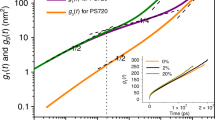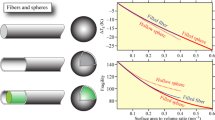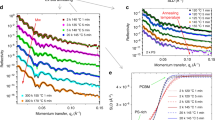Abstract
The thermomechanical responses of polymers, which provide limitations to their practical use, are favourably altered by the addition of trace amounts of a nanofiller. However, the resulting changes in polymer properties are poorly understood, primarily due to the non-uniform spatial distribution of nanoparticles. Here we show that the thermomechanical properties of ‘polymer nanocomposites’ are quantitatively equivalent to the well-documented case of planar polymer films. We quantify this equivalence by drawing a direct analogy between film thickness and an appropriate experimental interparticle spacing. We show that the changes in glass-transition temperature with decreasing interparticle spacing for two filler surface treatments are quantitatively equivalent to the corresponding thin-film data with a non-wetting and a wetting polymer–particle interface. Our results offer new insights into the role of confinement on the glass transition, and we conclude that the mere presence of regions of modified mobility in the vicinity of the particle surfaces, that is, a simple two-layer model, is insufficient to explain our results. Rather, we conjecture that the glass-transition process requires that the interphase regions surrounding different particles interact.
This is a preview of subscription content, access via your institution
Access options
Subscribe to this journal
Receive 12 print issues and online access
$259.00 per year
only $21.58 per issue
Buy this article
- Purchase on Springer Link
- Instant access to full article PDF
Prices may be subject to local taxes which are calculated during checkout





Similar content being viewed by others
References
Starr, F. W., Schroeder, T. B. & Glotzer, S. C. Effects of a nanoscopic filler on the structure and dynamics of a simulated polymer melt and the relationship to ultrathin films. Phys. Rev. E 64, 021802–021806 (2001).
Tran, T. A., Saï d, S. & Grohens, Y. Compared study of cooperativity in PMMA nanocomposites and thin films. Compos. A: Appl. Sci. 36, 461–465 (2005).
Becker, C., Krug, H. & Schmidt, H. Tailoring of thermomechanical properties of thermoplastic nanocomposite by surface modification of nanoscale silica particles. Mater. Res. Soc. Symp. Proc. 435, 237–242 (1996).
Tsagaropoulos, G. & Eisenberg, A. Dynamic mechanical study of the factors affecting the two glass transition behavior of filled polymers. Similarities and differences with random ionomers. Macromolecules 28, 6067–6077 (1995).
Bares, J. Glass transition of polymer microphase. Macromolecules 8, 244–246 (1975).
Lipatov, Y. S., Rosovitskii, V. F. & Maslak, Y. V. Glass transition in heterogeneous polymer systems with a high degree of phase separation. Polym. Sci. USSR 26, 1149–1154 (1984).
Besklubenko, Y. D., Privalko, V. P. & Lipatov, Y. S. Thermodynamics of filled poly(methyl methacrylate). Polym. Sci. USSR 20, 1473–1479 (1978).
Lipatov, Y. S. & Privalko, V. P. Glass transition in filled polymer systems. Polym. Sci. USSR 14, 1843–1848 (1972).
Ash, B. J., Siegel, R. W. & Schadler, L. S. Glass-transition temperature behavior of alumina/PMMA nanocomposites. J. Polym. Sci. B 42, 4371–4383 (2004).
Ash, B. J., Schadler, L. S. & Siegel, R. W. Glass transition behavior of alumina/polymethylmethacrylate nanocomposites. Mater. Lett. 55, 83–87 (2002).
Krishnamoorti, R., Vaia, R. A. & Giannelis, E. P. Structure and dynamics of polymer-layered silicate nanocomposites. Chem. Mater. 8, 1728–1734 (1996).
Zax, D. B. et al. Dynamical heterogeneity in nanoconfined poly(styrene) chains. J. Chem. Phys. 112, 2945–2951 (2000).
Dalnoki-Veress, K., Forrest, J. A., Murray, C., Gigault, C. & Dutcher, J. R. Molecular weight dependence of reductions in the glass transition temperature of thin, freely standing polymer films. Phys. Rev. E 63, 031801–031810 (2001).
Keddie, J. L., Jones, R. A. L. & Cory, R. A. Size-dependant depression of the glass transition temperature in polymer films. Europhys. Lett. 27, 59–64 (1994).
Ellison, C. J. & Torkelson, J. M. The distribution of glass-transition temperatures in nanoscopically confined glass formers. Nature Mater. 2, 695–700 (2003).
Ellison, T. J. & Torkelson, J. M. Sensing the glass transition in thin and ultrathin polymer films via fluorescence probes and labels. J. Polym. Sci. B 40, 2745–2758 (2002).
Forrest, J. A. & Dalnoki-Veress, K. The glass transition in thin polymer films. Adv. Colloid Interface Sci. 94, 167–196 (2001).
Forrest, J. A., Dalnoki-Veress, K. & Dutcher, J. R. Interface and chain confinement effects on the glass transition temperature of thin polymer films. Phys. Rev. E 56, 5705–5716 (1997).
Forrest, J. A., Dalnoki-Veress, K., Stevens, J. R. & Dutcher, J. R. Effect of free surfaces on the glass transition temperature of thin polymer films. Phys. Rev. Lett. 77, 2002–2005 (1996).
Forrest, J. A. & Mattsson, J. Reductions of the glass transition temperature in thin polymer films: Probing the length scale of cooperative dynamics. Phys. Rev. E 61, R53–R56 (2000).
Fukao, K. & Miyamoto, Y. Glass transitions and dynamics in thin polymer films: Dielectric relaxation of thin films of polystyrene. Phys. Rev. E 61, 1743–1754 (2000).
Fukao, K., Uno, S., Miyamoto, Y., Hoshino, A. & Miyaji, H. Dynamics of α and β processes in thin polymer films: Polyvinyl acetate and polymethyl methacrylate. Phys. Rev. E 64, 051807–051811 (2001).
Fukao, K., Uno, S., Miyamoto, Y., Hoshino, A. & Miyaji, H. Relaxation dynamics in thin supported polymer films. J. Non-Cryst. Solids 307, 517–523 (2002).
Long, D. & Lequeux, F. Hetrogeneous dynamics at the glass transition in van der Waals liquids, in the bulk and in thin films. Eur. Phys. J. E 4, 371–387 (2001).
Mattsson, J., Forrest, J. A. & Borjesson, L. Quantifying glass transition behavior in ultrathin free-standing polymer films. Phys. Rev. E 62, 5187–5200 (2000).
Mayes, A. M. Glass transition of amorphous polymer surfaces. Macromolecules 27, 3114–3115 (1994).
McCoy, J. D. & Curro, J. G. Conjectures on the glass transition of polymers in confined geometries. J. Chem. Phys. 116, 9154–9157 (2002).
Roth, C. B. & Dutcher, J. R. Glass transition temperature of freely-standing films of atactic poly(methyl methacrylate). Eur. Phys. J. E 12, S103–S107 (2003).
Sills, S. et al. Interfacial glass transition profiles in ultrathin, spin cast polymer films. J. Chem. Phys. 120, 5334–5338 (2004).
Singh, L., Ludovice, P. J. & Henderson, C. L. Influence of molecular weight and film thickness on the glass transition temperature and coefficient of thermal expansion of supported ultrathin polymer films. Thin Solid Films 449, 231–241 (2004).
Starr, F. W. & Glotzer, S. C. Simulations of filled polymers on multiple length scales. Mater. Res. Soc. Symp. Proc. 661, KK4.1/1–KK4.1/13 (2001).
vanZanten, J. H., Wallace, W. E. & Wu, W. -L. Effect of strongly favourable substrate interactions on the thermal properties of ultrathin polymer films. Phys. Rev. E 53, R2053–R2056 (1996).
Sharp, J. S. & Forrest, J. A. Free surfaces cause reductions in the glass transition temperature of thin polystyrene films. Phys. Rev. Lett. 91, 235701–235704 (2003).
Jean, Y. C. et al. Glass transition of polystyrene near the surface studied by slow-positron-annihilation spectroscopy. Phys. Rev. B 56, R8459–R8462 (1997).
Li, C. & Benicewicz, B. C. Synthesis of well defined polymer brushes grafted onto silica nanoparticles via surface reversible addtion-fragmentation chain transfer polymerization. Macromolecules 28, 5929–5936 (2005).
Acknowledgements
The authors are grateful to the National Science Foundation for funding this research through a Nanoscale Science and Engineering Center Grant. Additional funding was provided by the NSF Division of Materials Research (S.K.K.), Eastman Kodak (B.C.B., S.K.K. and L.S.S.) and the Office of Naval Research (S.K.K. and L.S.S.). The authors also thank R. Krishnamoorti, S. Granick, S. S. Sternstein, P. Keblinski, J. Forrest, M. T. Takemori and A. Eitan for discussions and comments, W. Kim for gel permeation chromatography experiments, A. Kumar for SEM images and the 2001 Mettler–Toledo Thermal Analysis Educational Grant for DSC and TGA. K.C. would like to thank the Ministry of Science and Technology of Korea (National Research Laboratory Program) for their funding.
Author information
Authors and Affiliations
Corresponding authors
Ethics declarations
Competing interests
The authors declare no competing financial interests.
Supplementary information
Supplementary Information
Supplementary figures S1 and S2 (PDF 277 kb)
Rights and permissions
About this article
Cite this article
Bansal, A., Yang, H., Li, C. et al. Quantitative equivalence between polymer nanocomposites and thin polymer films. Nature Mater 4, 693–698 (2005). https://doi.org/10.1038/nmat1447
Received:
Accepted:
Published:
Issue Date:
DOI: https://doi.org/10.1038/nmat1447
This article is cited by
-
Unraveling bilayer interfacial features and their effects in polar polymer nanocomposites
Nature Communications (2023)
-
Deformation Behavior and Its Effect on the Mechanical Properties of Nanoparticles in Pure Nanoparticle-Modulated System
Journal of Materials Engineering and Performance (2023)
-
Alternating chain sequence weakening of interfacial molecular interactions enhances the Tg confinement effect of polymers
Polymer Journal (2022)
-
Molecular picture of fluoropolymer adsorption on nanocarbon materials
Polymer Journal (2021)
-
Microbial cells as biological factory for nanoparticle synthesis
Frontiers of Materials Science (2021)



